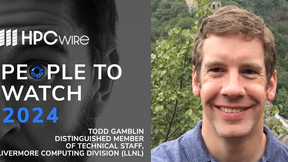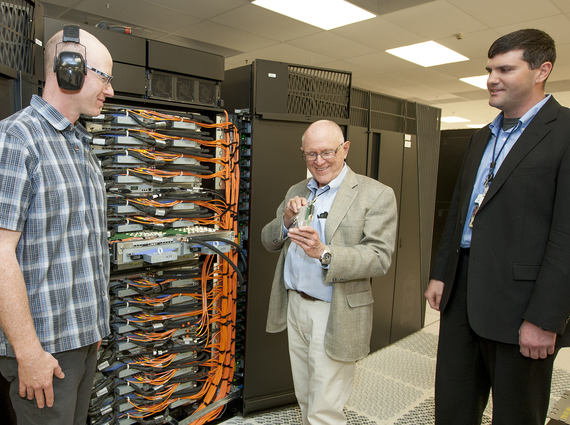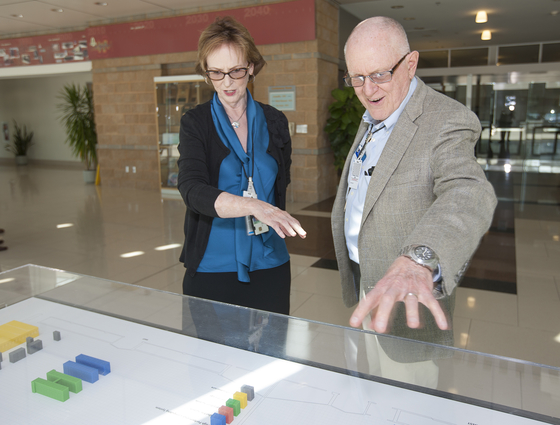Gordon Bell reminisces and gets a look at the HPC revolution he helped foment
But when it comes to high performance computing at LLNL, much has changed thanks to the computing technology revolution Bell helped bring about. Bell's presentation, "The Supercomputer Class Evolution: A Personal Perspective," before a packed auditorium Wednesday was a PowerPoint journey through time from the Lab's earliest supercomputing systems in the early 60s to today's era of massively parallel computing systems.
Over the five decades he has worked as a computer engineer, inventor, entrepreneur and futurist, Bell has lost none of his enthusiasm for high performance computing and the possibilities of electronics technologies.
Bell used his own "Bell's Law of Computer Classes," the subject of a 1972 article he authored, as the framework for discussing the evolution of supercomputing since the 1960s. The emergence in the 60s of a new, lower cost computer class based on microprocessors formed the basis of his law. Bell posited that advances in semiconductor, storage and network technologies brought about a new class of computers every decade to fulfill a new need. Classes include: mainframes (1960s), minicomputers (1970s), networked workstations and personal computers (1980s), browser-web-server structure (1990s), palm computing (1995), web services (2000s), convergence of cell phones and computers (2003), and Wireless Sensor Networks aka motes (2004).
Mixing well documented technical history with personal reminiscences, Bell explained the tangibles and intangibles of what has defined a supercomputer. Apart from such technical performance metrics such as clock speed, there is a wow factor that's more difficult to define, he said. "A supercomputer to an engineer is something that is so grand, so big and breathtaking for its time." Talking about the CDC 6600, a mainframe supercomputer built by Control Data Corp. and deployed at LLNL in 1964, Bell said, "I was blown away by the beauty and elegance of the machine."
Another system that captivated his imagination was the UNIVAC Livermore Advanced Research Computer (LARC) system, acquired in 1960. "How do you know a supercomputer?" he quipped. "You have to ask me."
Bell discussed the advent of massively parallel computing in the 1980s, an approach he had championed since the early 70s, noting that the search for parallelism was littered with failures. He credited pioneers such as the Laboratory's George Michael for helping to bring about the revolution in supercomputing design and also acknowledged the contributions of LLNL's Eugene Brooks, who coined the phrase "killer micros" - a reference to the microchip technology that made massive parallelism possible.
"It's hard to understate the importance of Gordon Bell to supercomputing as we know it today. While he was known as an architect and as an entrepreneur, for me personally his great charm and greatest contribution has been his ability to understand and then communicate in a very pithy, often funny and understandable manner very deep or complex trends in computing - for example, comments attributed to him include 'the network becomes the system' or 'the most reliable components are the ones you leave out,' which often popped into my head this past year as we struggled with integrating a 20PF system," said Michel McCoy, head of LLNL's Advanced Simulation and Computing Program. "He has also been a part of the Lab's history in supercomputing, showing us today that his passion for supercomputers and his belief in their importance in advancing human civilization is undiminished."
Bell later met with McCoy, Computation Associate Director Dona Crawford, Engineering's Rob Sharp, Bert Still and Fred Streitz to discuss current HPC challenges. He toured of the TSF and the National Ignition Facility (NIF). During his daylong visit, he also met with Director Parney Albright and lunched with computational engineers and early career computer scientists. Bell, who received his MS in Electrical Engineering from MIT, was recruited in 1960 to the Digital Equipment Corporation where he spent 23 years designing computers, notably the PDP series. He later helped found several computer companies and worked at the National Science Foundation. He's a member of the National Academy of Engineering and the National Academy of Science and has earned many national and international honors. Currently, Bell is a researcher emeritus at Microsoft, working on 'Lifelogging.'
For more about Gordon Bell, see his homepage .
Contact
Donald B Johnston[email protected]
925-423-4902
Tags
HPC, Simulation, and Data ScienceComputing
HPC Innovation Center
Featured Articles










